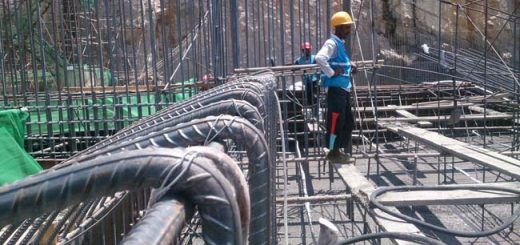All about Workability of Concrete
Workability of concrete a foremost important as the compressive strength of the concrete. If concrete is not workable, construction work is very difficult. It is very difficult to handle the low workable concrete. Further, it could lead to the quality issue of construction.
Further, workable concrete allows concrete pouring easier.
Following issues could arise due to the low workable concrete
- Poor compaction
- Formation of the honeycombs
- Difficulty in flowing concrete in the areas where the reinforcement congestion is higher
- Difficulty in handling the concrete at site
A workable concrete is a must to do construction work without much difficulty. Therefore, it is much important to study the factors affecting workability of concrete.
Factors Affecting Workability of Concrete
- Water Cement Ratio
- Mix Proportions
- Size of the Aggregates
- Shape of the Aggregates
- Grading of Aggregates
- Surface Texture of Aggregates
- Effect of the Clay Content
- Effect of Recycled Fine Aggregates
- Use of the Admixtures
- Use of the Supplementary Cementitious Materials
- Time
- Temperature
Water Cement Ratio
The water-cement ratio is an indicator of the content of water added to a concrete mix. The water-cement ratio decided at the mix design is kept at constant for a particular concrete mix. It implies that a constant water content will be added for the concrete mix.
More the water in the concrete, the more the workability of concrete. However, we cannot add water as we wish. Water shall only be added as specified in the mix design.
Mix Proportions
The aggregate to cement ratio is affecting the workability of concrete. When the aggregate to cement ratio increases, there is less cement paste. Therefore, workability is reducing.
The reduction of the aggregate to cement ratio leads to an increase in the workability of concrete. Further, this ratio is controlled the mix design to achieve to required consistency of the concrete.
Size of the Aggregates
Size o the aggregate makes a considerable impact on the concrete workability.
The larger aggregate has a higher surface area. However, if we consider the same volume of the aggregates, the sample with smaller aggregates have a higher total surface area when compared with the sample having larger size aggregates.
When the size of the aggregates is lesser, the amount of water required to make the concrete workable is higher. Further, when the size of the aggregate is large, less water is required to make the concrete workable.
Shape of the Aggregates
The shape of the aggregate makes a considerable impact on concrete workability. The following types of aggregate can be observed. Further, the article testing of aggregates discusses available tests for aggregates.
- Angular aggregate
- Flaky aggregate
- Elongated aggregate
- Rounded aggregate
- Sub-rounded aggregate
- Cubical aggregate
Generally, round aggregates are more convenient to mix when compared with other types of aggregates. Irregular type of aggregate has less workability due to the above reason.
Grading of Aggregates
Well-graded aggregates have higher workability of concrete.
If the aggregates are graded well, the void in the concrete will be minimal. It increases the workability of concrete.
Further, the reduction of the voids in the concrete avoids the segregation of concrete.
Surface Texture of Aggregates
Aggregates having smoother surface areas produce a more workable concrete mix than that of having a rough surface.
If the surface is rough, it has more friction and as a result, the workability will reduce.
Further, water absorption is less when the surface texture is smoother, and it improves the workability comparatively.
Effect of the Clay Content
Clay is added to the concrete in ancient construction as a replacement to the cement. It reduces the cost of construction.
Construction of brick walls, plastering can be done by adding the clay.
The figure extracted from a technical paper shows the variation of the consistency and the setting times of the concrete.
As indicated in the above figure, there is a considerable impact on the consistency of concrete based on the content of the clay in the concrete.
Effect of Recycled Fine Aggregates
Recycled fine aggregates are made from breaking the concrete cubes in the testing laboratory.
This material is not widely used in construction.
Base on one of the studies done on this subject, they have obtained the following relationship.
Admixtures
There are different types of concrete admixtures and the purpose of using them is also varied.
There are admixtures to improve the workability of concrete without adding water to concrete.
It is a greater advantage as if we have good workability with less content of water, there is a possibility of increasing the strength of the concrete.
For example, if we consider the control mix having done for certain water-cement ratios, we will get some workability. If we add a water-reducing admixture without changing the water-cement ratio, we will get higher workability than the control mix.
So, we can reduce the content of the water to match the workability. If we use the same cement content it reduces the water-cement ratio. Further, it increases the strength of the concrete.
Apart from that, with the addition of the water reducer, we can reduce the water content as discussed above. Thus, we can reduce the cement content to maintain the same water-cement ratio. It does not change the strength of the concrete.
If come to the exact tropic, in summary, we can control the workability of concrete with admixtures.
Use of Supplementary Cementitious Materials
We use fly ash, silica fume, ggbs, etc are used as cementitious materials in concrete production.
The article cement and cement additives discuss the materials added to the concrete.
They are added as replacement or additive to the concrete.
For example, we produce concrete for thick concrete, fly ash is added to the concrete to reduce the heat generated in the hydration process.
These materials have higher surface area compared with the cement and they improve the reactivity of the concrete.
The addition of supplementary cementitious materials improves the workability of the concrete.
Time
Effect of the time on the workability of concrete quite known factors.
Whatever we do can not control the drop of the workability of concrete.
The conventional mix drops the slump of the concrete rapidly.
However, the addition of the admixtures like superplasticizers can retain the slump for a certain period. It could be sufficient for proceeding with the construction work.
After a certain period, it starts dropping rapidly even though an admixture is added.
Temperature
Rising temperature in the concrete increases the rate of evaporation of the water in the concrete mixture. It leads to reduce workability.
Method of Limiting Temperature of Concrete is an article to discuss the procedure to be followed in reducing the temperature rise in the concrete. Further, this article is not directly linked to this subject.
Environmental temperature also directly affects concrete workability. When the temperature rises, evaporation increases.
Methods of Measurement of Workability of Concrete
The measuring methods can be categorized based on the available type of concrete.
- Normal concrete
- Self-compacting concrete
The above classification was made for defining the slump tests.
Normal Concrete
In normal concrete, we check the slump, which can be considered as indicated of the workability, to make sure the condition of the concrete before pouring.
The article concrete testing provides detailed information about the testing of concrete. There is more information about the slump test.
Self Compacting Concrete
There are many tests available to check the concrete consistency. The following table indicates the details of the tests.
| Filling Ability Test | Passing Ability Test | Segregation Resistance Test |
| Slump Floor Test | J-Ring Test | V-funnel at T5 minutes |
| T50cm Slump Flow | L-Box Test | GTM Screen Stability Test |
| V-Funnel Test | U-Box Test | |
| Orimet | Fill-Box Test |






